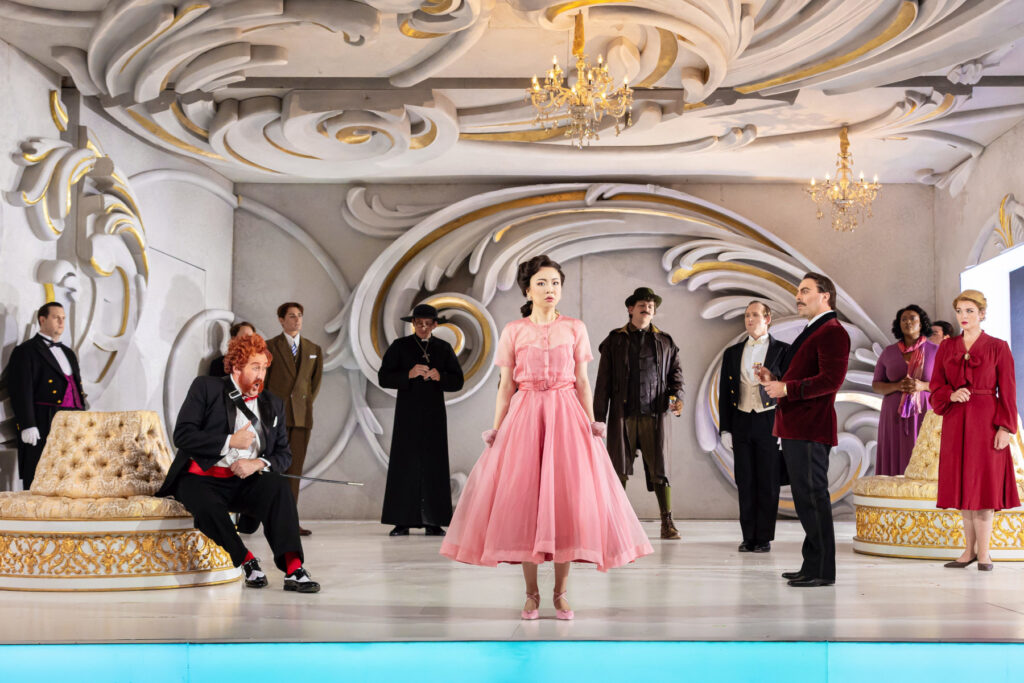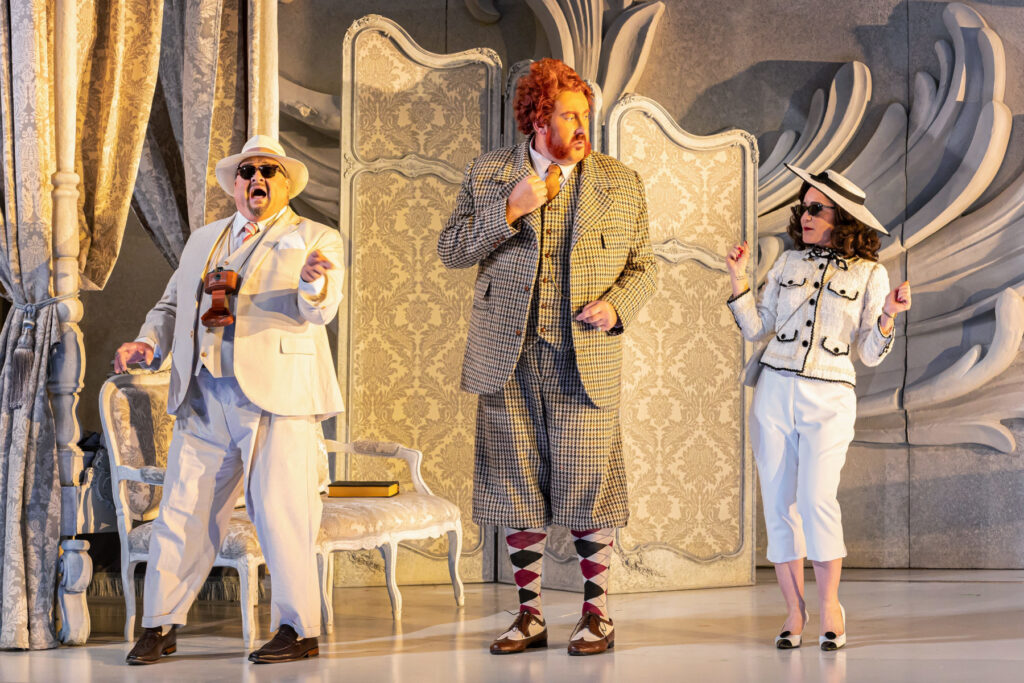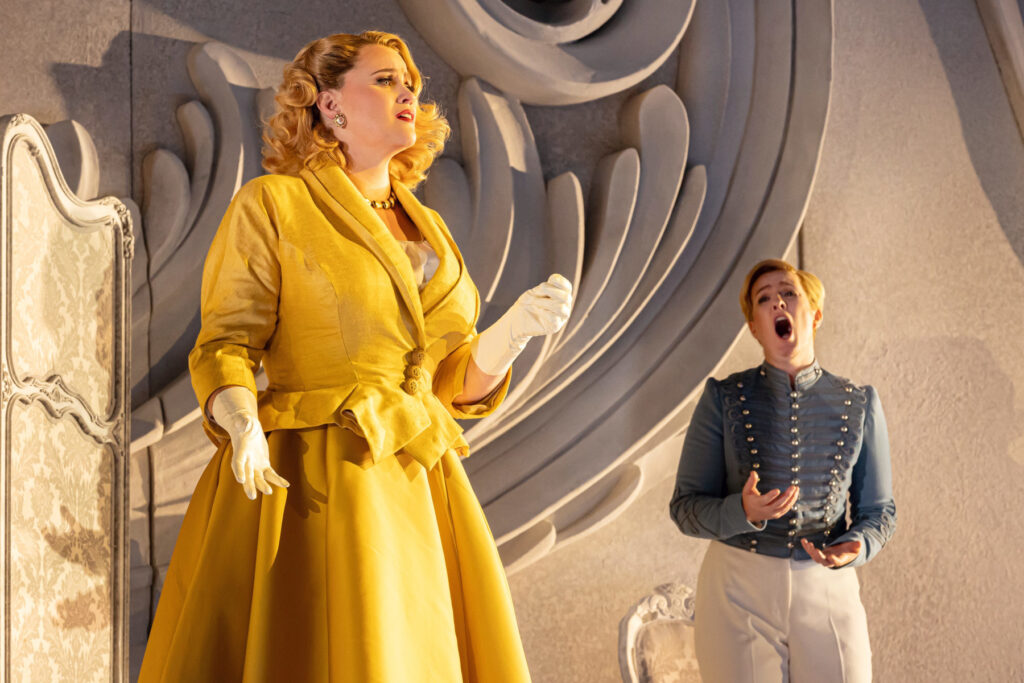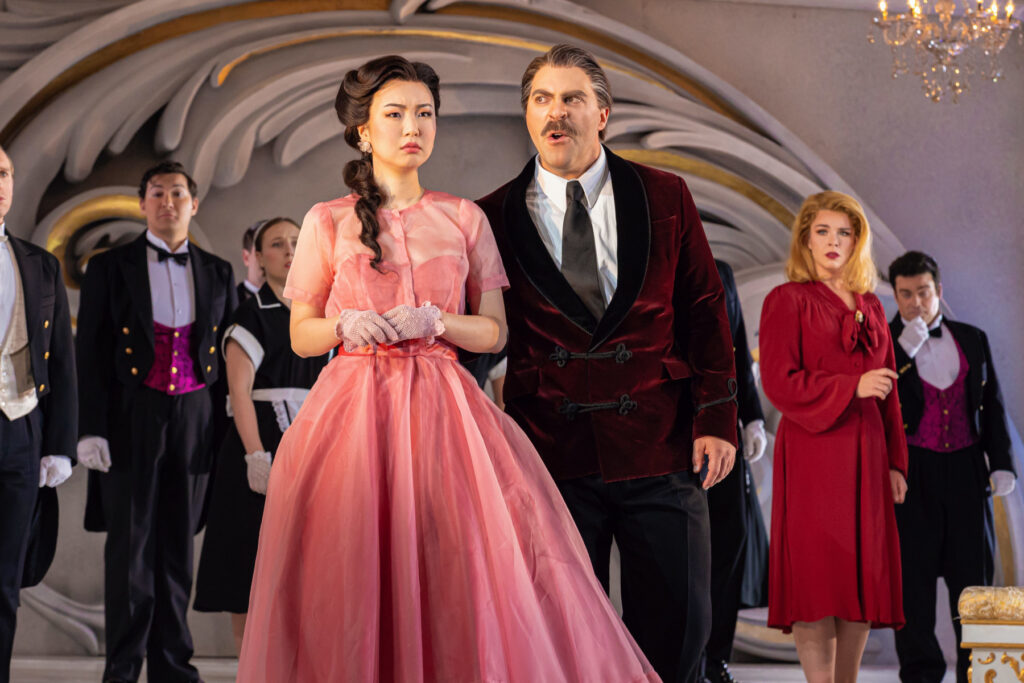Let me cut right to the chase and say that Santa Fe Opera’s stunning production of Strauss’s Der Rosenkavalier has driven me stark raving glad.
It was a long-awaited thrill to once again experience this storied festival back at very top form, with this meticulously cast, handsomely designed, lovingly directed, and resplendently played virtuosic masterpiece. There was no aspect of this stirring event that didn’t exude effortless excellence.

That the orchestra sounded as fine as any I have ever experienced playing this exceedingly challenging score, was owing to the towering leadership of conductor Karina Canellakis. Under her inspiring baton, Maestra Canellakis brought a sweep and arc to the lengthy opus that was notable not only for its stylistically flawless ensemble stretches, but also for the unflagging attention to varied and vibrant colors rarely evoked to such fine effect. The impeccable, and frequent playful solo work was beyond praise. There was such a richness of details that I never noticed before that this seemed a definitive version coaxed into being by a superstar on the rise: Brava, Karina Canellakis. Bravi, tutti struministi.
The starry cast was anchored by the incomparable Rachel Willis-Sørenson as a radiant Marschallin. I have enjoyed this fine soprano on other occasions, but nothing could have prepared me for her complete mastery of this complex iconic role. Her golden, ample, even instrument was a perfect fit as she purred, soared, conversed, reflected, and sang the spots off the page. Ms. Willia-Sørensen is also an elegant beauty, and her lengthy reflection on age and the passing of time had unutterably poignant resonance. Musically and dramatically then, hers was as fine a Marschallin as is attainable.

Alongside her co-star’s accomplishment, mezzo-soprano Paula Murrihy proved to be a winning Octavian. The part is one of opera’s most famous “trouser roles,” that is a woman playing a man, the voice ype suggesting a youthful male. Ms. Murrihy’s stage savvy paid off with a coyly swaggering impersonation, and considerable abandon in his/her amorous interest in the ladies. Octavian is also called upon to disguise “himself” as a serving maid, which Murrihy serves up with relish. And she sings, too! Her voice has the perfect weight, range, and rich, rounded timbre for this major Strauss assumption, and her voice rings out with assured authority.
Rounding out the trio of leading ladies, lovely Ying Fang was a dreamy Sophie in every way. Her effortless, gleaming lyric soprano could float with hushed ethereal beauty, or swell to crest the orchestra with consummate ease. Her love struck idealism was winningly communicated, and her optimism was warmly infectious. But when she was affronted, her delivery was capable of real sass and mettle. Near the end of this long, glorious outing, Fang, Murrihy, and Willis-Sørenson regaled us with a sumptuous and heart-rending rendition of the famous trio in which the Marschallin relinquishes Octavian to the young Sophie. As the emotions and phrases tumbled over each other urgently in rising intensity, there can’t have been a dry eye in the house.

As counterbalance to all this elegance and refinement, Matthew Rose was a perfect foil as the boorish Baron Ochs. Mr. Rose has a polished, pleasing and secure bass. On this occasion, he ably colored his well-voiced delivery to snarl, cajole, bully, and pursue his ends with a comic skill that was grounded in honesty. He is a tall, imposing man whose physical manner could veer easily between unintended bumbling and intended menace. He made Ochs a highly enjoyable faux villain you couldn’t hate, much less look away from, and his was a memorable interpretation.
As the scheming duo Valzacchi and Annina, Gerhard Siegel and Megan Marino, respectively, were animated, laser-voiced delights. Mr. Siegel’s assured tenor had clarion presence, his top register had a stinging delivery, and his stage comportment and diction were admirable. Ms. Marino may cut a petite figure, but don’t let that make you underestimate her fire power. Her potent mezzo-soprano was well-rounded, cheekily hurled into the house, and even throughout the range but with an exceptionally potent low register. Together the plotters executed some wonderful unison gestures that punctuated their sassy shenanigans.
Faninal was delivered as an unctuous bargainer by baritone Zachary Nelson, the gorgeous timbre and mellifluous outpouring of his poised singing tinged with urgent dramatic persuasiveness. Marianne proved a congenial fit for Kathryn Henry’s vibrant, appealing soprano, and she made every bar count in her authoritative presence and confident vocalizing. David Portillo was a bit of deluxe casting, his resonant, pure tenor confidently encompassing all the high flying demands scored for the Italian Tenor. All of the named roles were well-served, notably Scott Conner who made a fine impression as the Police Commissioner with his crisp, bounteous bass; and Keith Kline, whose muscular, substantial bass lit up the stage and perked up our ears in his scene as the Notary.

The Marschallin’s non-singing black page was here reimagined as Cupid, adorably embodied by young Maximilian Moore, whose every appearance was a treat. And to his credit, Master Moore’s energy and focus never flagged, even after the clock had struck midnight, surely well past his usual bedtime. The choral moments were prepared by Chorus Master Susanne Shelton and their cries of Rofrano in Act II were moments of full-throated glory. Every single role was cast from strength, and as you read the cast list below, please know that each was performed with outstanding vocalism, dramatic purpose, and unified style.
It is impossible to over praise the opulent, awesome set and costume design from the supremely gifted Gary McCann, but “eye-popping” comes close to a fit. The first act boudoir box set establishes the tone with its white walls alive with sculpted swirls, sweeping vines and elongated leaves, and suggestions of roses. The massive back walls are parted for entrances (and espionage), and a curtained bed flanks the stage right wall. The stage left is a massive open “window” to the street below, from which we first hear the Italian Singer (as a flower vendor). (He is summoned and sings the second refrain on stage.)
Act II is a similar-but-different white box, again with raised patterns on the walls and ceiling, but is lavishly decorated with rich looking pouffes, upholstered chairs and four crystal chandeliers to convey von Faninal’s noveau-riche aspirations. For one of the best visual “Presentation of the Rose” effects ever, the massive up center walls parted to reveal Octavian posed in his elegant military garb, against a colorful sunset worthy of Fragonard. Its incomparable beauty prompted gasps and spontaneous applause. The tawdry-chic of the “room erected within the white stage box” was a worthy milieu for Och’s ill intentions. The only reservation I had was that it took nearly forty minute to install during the second intermission.
Mr. McCann’s costume design was every bit as impressive. The decision seems to have been made to present the Marschallin as played by Princess Grace, so everything suggested the 1950’s with its stylish formality. Ms. Willis-Sørenson in her blond wig would not have been out of place on Vanity Fair. Up and down the cast list, McCann created precise looks that visually defined the characters, and filled the stage with a dizzying array of textures and colors. Baron Ochs’ imposing larger than life stature was amusingly accented by marginally tasteful “finery” and a garish ginger beard and wig.
Lighting designer Malcom Rippeth has worked hand in glove with Mr. McCann to flood the stage with subtly shifting effects that deepen the dramatic moments, then turn around on a dime and heighten the comic exchanges. The solemn ceremonial raising of the chandeliers to the ceiling in Act II, only to have them sputter and fall halfway down again before being righted, was a great lighting/staging gag. Mr. Rippeth’s many specials were well-judged and meaningful.
The frosting on the top of this very rich Sachertorte, was the masterful direction by Bruno Ravella. From the very first note, when a spotlit rose popped up from the stage floor, then was brought up into the boudoir by an impish Cupid, the tone was set that this was going to be a surprising traversal of this thrice-familiar opera. To be sure, Mr. Ravella nurtured believable, nuanced character relationships, that were informed by subtext, and admirable in their powerful chemistry. But he also found every opportunity for humor grounded in reality, and the subtle humorous touches merited the profusion of laughs they received. His interwoven light touches also set up the wrenching melancholy of the dramatic reckoning, no more so than the antics that subside and blend into that final trio.
In otherwise rather uneven seasons in the recent past, the breathtaking musical and dramatic achievement of this Der Rosenkavalier was proof positive that Santa Fe Opera is more than capable of living up to its esteemed repute. Fabelhaft!
James Sohre
Der Rosenkavalier
Music by Richard Strauss
Libretto by Hugo von Hoffmannsthal
Cast and production staff:
Cupid: Maximilian Moore; Octavian: Paula Murrihy; The Marschallin: Rachel Willis-Sørenson; Baron Ochs: Matthew Rose; The Marschallin’s Major-Domo: Wayd Odle; Four Lackeys: Matthew Goodheart, Randall McGee, David Bogaev, Bernardo Medeiros; Noble Widow: Anneliese Klenetsky; Three Noble Orphans: Isobel Anthony, Ashlyn Brown, Christina Grohowski.
Dressmaker: Natasha Isabella Gesto; Animal Tamer: Nathan Bowles; Valzacchi: Gerhard Siegel; Annina: Megan Marino; Notary: Keith Klein; Italian Singer: David Portillo; Leopold: Nicholas Sipes; Sophie: Ying Fang; Herr von Faninal: Zachary Nelson; Marianne Leitmetzerin: Kathryn Henry; Faninal’s Major-Domo: Ryan Bryce Johnson; Innkeeper: Spencer Hamlin; Four Waiters: Garrett Evers, Nathan Bowles, Tzvi Bat Asherah, Drew Comer; Police Commissioner: Scott Conner; Boots: Dylan Gregg; Conductor: Karina Canellakis; Director: Bruno Ravella; Set and Costume Designer: Gary McCann; Lighting Designer: Malcolm Rippeth; Chorus Master: Susanne Sheston
Top image: L – R Rachel Willis-Sørensen (Marschallin), Paula Murrihy (Octavian).
All photos by Curtis Brown for the Santa Fe Opera.